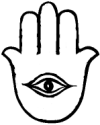All-Seeing Eye Cross

We could say that God is watching every move we make, so we'd better behave ourselves. That's true, of course, but sounds a bit scary (see also God fearing).
Alternatively, it can be seen as God watching over us, like a father, ready to lend a hand if we call on Him.
This page takes a cross-eyed look at the Eye and the Cross.
The All-Seeing Eye, sometimes called the Eye of Providence, represents God's omniscience and omnipresence and has been used by innumerable organisations and cults. It appears on the Great Seal of the United States, its dollar bills, on bills of other countries (Ukraine and Estonia), and on the tee-shirts of rock band artists.

Hamsa
(Khamsa or Chamsa)
It is used by some as an apotropaic talisman, to reflect back harm. It appears in Islam and Judaism with the Phoenician Hamsa (Khamsa or Chamsa), although conservative Muslims and Jews may consider such talismans a form of idolatry.
In Islam, the Hamsa is known as the Hand of Fatima or Eye of Fatima, named after Muhammad's youngest daughter. She had several titles, the popular ones being Faṭimah al-Zahra (the shining one) or Faṭimah al-Batul (the pure one) and was Muhammad's only survivor into adulthood. Therefore she was able to bear descendants from Muhammad's line and has taken on a revered position in Islamic theology, just as Mary has with Catholics.
The Jewish name for the Hamsa is Hand of Miriam, in reference to the Prophetess in Exod. 2:1-10, sister of Moses and Aaron, and inspiration for modern day Jewish feminists. (These are not your bra-burners and Germaine Greer wimmin, but a group of people dedicated to seeing that women can take a more active role in the historically male-dominated religion.)
Such talismans are meant to protect the holder from the 'Evil Eye' - a curse invoked by the sin of envy, or simply looking upon something with envy.

Eyes have a profound psychological effect on us, and for this reason, an image of an eye (or pair of eyes) is used in many contexts.
An experiment in 2006 at Newcastle University, England, showed that a photograph of a pair of man's eyes, looking directly at the observer, induced honesty. (newscientist.com/article.ns?id=dn9424)

Over-large eyes can be cute or scary, depending on the context.
Sunglasses can look like huge dark eyes. Police and soldiers wear them to intimidate; gangsters and pimps in cocaine-white Mercedes wear them for disguise. (The Blues Brothers look cool in shades, but otherwise, wearing them at night, indoors, or perched on top of the head, just looks comical.)
Eyes can also be made to look larger with make-up. Footballers in he USA started wearing eye black at the top of their cheeks in the 1940s to reduce glare from the sun, and found it also had useful intimidating effects.
As in many other countries, schoolgirls in Japan rebel against their high school uniform code at the weekend by donning extreme ganguro fashion. A new style every season of course, and excessive eye make-up is essential.
The 1990s yamamba style for example; "I've just got back from surfing in Hawaii. My tan, sun-bleached hair and panda eyes prove it."
Staying on the topic of wild animals, we see birds, insects and fish use false eyes or ocelli to fool predators.
In the case of the 'Owl' butterfly, the large 'eye' on its wing is used both as a decoy (predators attack the wing rather than the body) and as a repellent (predators think the eye is from a larger adversary).
The 'eyes' on the wings of the common peacock butterfly are enough to scare away a chicken 10,000 times heavier than the butterfly, a similar ratio to the mouse and lion in Aesop's fables.

Eyes painted on lure
to attract fish

Eyes are painted on boats to protect the superstitious fishermen from the 'Evil Eye' (fascinatio in Roman mythology, maloccio in modern Italian) - a curse invoked by the sin of envy, which can initiate a spate of bad fortune.
Popularly believed in many Mediterranean cultures, you can counter the Evil Eye with a pair of painted eyes, as seen on the upper bow of this Maltese fishing boat.

All of this is far removed from the All-Seeing Eye Cross; a symbol used by Christians. This symbol comprises an eye and a cross, and often includes a triangle and/or twelve rays of Glory.
If a triangle is included, this represents the Trinity of God the Father, Jesus Christ His Son, and the Holy Spirit. (Note: a pyramid has all sorts of alleged supernatural properties, which most people dismiss as 'pyramidiotic' nonsense. On this cross, we show a triangle. A triangle is not a pyramid.)
The All-Seeing Eye symbolises the eye of God, keeping watch on mankind. How we interpret that is up to each of us. We could say that God is watching every move we make, so we'd better behave ourselves. That's true, of course, but sounds a bit scary (see also God fearing). Alternatively, it can be seen as God watching over us, like a father, ready to lend a hand if we call on Him (see also Guardian Angel).
And finally...
Zoe Lyons from Wales, famous for countering discrimination with witty humour, was runner up for the best one-line joke at the 2016 Edinburgh Fringe Festival with her entry:
- "I'll tell you what's unnatural in the eyes of God. Contact lenses."
And since we've got your attention...
Late one night, a burglar breaks into a house. He tiptoes through the living room but suddenly freezes in his tracks when he hears a loud voice shrieking: "Jesus is watching you!"
Silence returns to the house, so the burglar creeps forward again. "Jesus is watching you!" the voice cries and the burglar again stops dead in his tracks. Frightened, he switches on his torch and looks all around the room. And there, over in a dark corner, he sees a parrot sitting on a perch. "Jesus is watching you!" squawks the parrot.
"Phew!" sighs the burglar, "That's a relief; I thought my conscience was working overtime! Who's a clever parrot then? What's your name?"
"Bernard." replies the bird.
"Bernard? That's a stupid name for a parrot." sneers the burglar.
"Yes," replies the parrot, "and Jesus is a stupid name for a Rottweiler!"
For the inquisitive, no, we haven't weighed any particular butterfly that has scared away a chicken, or weighed that chicken. Neither have we bothered to try to weigh any particular mouse or lion. Instead we've taken the average weight of 0.1 grams for a butterfly, 1 kg for a chicken, 20 g for a mouse and 200 kg for a lion. And if that isn't scientific enough, please substitute "10,000 times heavier" with "an awful lot heavier".


